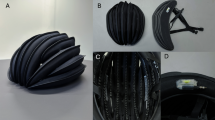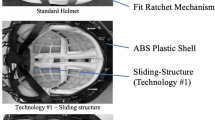Key Points
-
The wearing of cycle helmets not only reduces the incidence and severity of head and brain injuries and their long-term consequences, but also facial and some dental trauma.
-
Previous assessments of helmet efficacy have focussed on mortality rates; morbidity rates, including the effects of maxillofacial and dental trauma, have been neglected.
-
The dental profession could contribute significantly to promotional campaigns.
-
There is scope for further research into modification of helmet design to improve facial and dental protection.
Abstract
Objectives To review the available literature regarding the: epidemiology of bicycle related head injuries; consequences of head injuries; rates of cycle helmet use; impact of educational campaigns and legislation on usage rates; effectiveness of cycle helmets in protecting against head and facial injuries; arguments against the compulsory use of bicycle helmets
Data sources A computerised Medline search was conducted using the keywords: head injury, facial injury, bicycle helmets, accidents.
Data selection All available information was considered.
Data synthesis Data was collated manually.
Conclusions The wearing of bicycle helmets contributes significantly to the prevention of head injuries (HI) and traumatic brain injury (TBI), particularly in children and adolescents.
There is evidence to support the role of cycle helmets in the prevention of injuries to the middle third of the face and some dental injuries. There is a case for the implementation of legislation accompanied by educational campaigns to increase significantly the use of cycle helmets.
The dental profession could: play an active role in promoting cycle helmet use; support calls for the compulsory wearing of cycling helmets, particularly for children; press for modification of helmet design and standards to increase protection of the face.
Similar content being viewed by others
Log in or create a free account to read this content
Gain free access to this article, as well as selected content from this journal and more on nature.com
or
References
Mann NP, Lee AJ . Bicycle helmets: their role in injury prevention. Curr Paediatr 1999; 9: 173– 1766.
Road Accidents Great Britain: 2000 — The Casualty Report. Department of Transport Local Government and the Regions, London 2001
Road Accidents Great Britain: 2002 — The Casualty Report. Department of Transport Local Government and the Regions, London 2003
Lee AJ, Mann NP, Takriti R . A hospital led promotion campaign aimed to increase bicycle helmet wearing among children aged 11–15 living in West Berkshire 1992-98. Injury Prevention 2000; 6: 151– 153.
Jennett B . Some international comparisons. In H S Levine, H M Eisenberg, A L Benton (eds). Mild Head Injury. New York: Oxford University Press, 1989, pp23-34 cited in Satz P, Zaucha K, McCleary C, Light R, Asarnow R, Becker,D. Mild head injuries in children and adolescents: A review of studies (1970-1995). Psychol Bull 1997; 122: 107– 131.
Sosin SM, Sacks JJ, Webb KW . Pediatric head injuries and deaths from bicycling in the United States. Pediatrics 1996; 98: 868– 870.
Li G, Baker SP, Fowler C, DiScala C . Factors related to the presence of head injury in bicycle-related pediatric trauma patients. J Trauma: Injury, Infection Critical Care 1995; 38: 871– 875.
Cook A, Sheikh A . Trends in serious head injuries among cyclists in England: analysis of routinely collected data. Br Med J 2000; 321: 1055.
Takriti R, Lee AJ . An analysis of teenage attitudes towards bicycle helmet wearing Reading, UK. The Bicycle Helmet Initiative Trust 2000, BHIT report No 1125.
Quine L, Rutter DR, Arnold L . Persuading school-age cyclists to use safety helmets: Effectiveness of an intervention based on the theory of planned behaviour. Br J Health Psychol 2001; 6: 327– 345.
Lee AJ, Takriti R . Pedal cycle injuries among the under sixteens and the possible effect of helmets in reducing head injury Reading, UK. The Bicycle Helmet Initiative Trust 2000, BHIT report No 1120.
McDermott F . Bicyclist head injury prevention by helmets and mandatory wearing legislation in Victoria, Australia. Ann R Coll Surg Eng 1995; 77: 38– 44.
Moss NEG, Wade DT . Admission after head injury: how many occur and how many are recorded? Injury 1996; 27: 159– 161.
Wrightson P, McGinn V, Gronwell D . Mild head injury in preschool children: evidence that it can be associated with a persisting cognitive defect. J Neurol, Neurosurg Psychiatry 1995; 59: 375– 380.
Acton CHC, Thomas S Nixon JW, Clark R Pitt, WR, Battistutta D . Children and bicycles: what is really happening? Studies of fatal and non-fatal bicycle injury. Injury Prevention 1995; 1: 86– 91.
Acton CHC, Nixon JW, Clark RC . Bicycle riding and oral/maxillofacial trauma in young children. Med J Aust 1996; 165: 249– 251.
Harrison MG, Shepherd JP . The circumstances and scope for prevention of maxillofacial injuries in cyclists. J R Coll Surg Edin 1999; 44: 82– 86.
Thompson DC, Rivara FP, Thompson R . Helmets for preventing head and facial injuries in bicyclists (Cochrane Review) In The Cochrane Library, Issue 3, 2001. Oxford: Update Software.
Wiederholt WC . Neurology for non-neurologists. 4th ed Philadelphia: WB Saunders and Co, 2000, pp 297– 304.
Talamonti G, Fontana PP, Versari F, et al. Delayed complications of ethmoid fractures: a 'growing fracture' phenomenon. Acta Neurochirurgica 1995; 137: 164– 173.
Marsden CD, Fowler TJ . Clinical Neurology 2nd ed. London: Arnold, 1998, pp 272– 282.
Thornhill S, Teasdale GM, Murray GD, McEwen J, Roy CW, Penny KI . Disability in young people and adults one year after head injury: prospective cohort study. Br Med J 2000; 320: 1631– 1635.
Deb S, Lyons I, Koutzoukis C Nueropsychiatric sequelae one year after a minor head injury. J Neurol Neurosurg Psychiatry 1998; 65: 899– 902.
Bogan AM, Livingston MG, Parry-Jones WLI, Buston KM, Wood SF . The experiential impact of head injury on adolescents: individual perspectives on long-term outcome. Brain Injury 1997; 11: 431– 443.
Teasdale TW, Engberg AW . Suicide after traumatic brain injury: a population study. J Neurol Neurosurg Psychiatry 2001; 71: 436– 440.
Holsinger T, Steffens DC, Phillips C, Helms MJ, Havlik JJ, Breitner JCS, Guralnik JM, Plassman BL . Head injury in early adulthood and the lifetime risk of depression. Arch Gen Psychiatry 2002; 59: 17– 22.
Plasman BL, Havlik RJ, Steffens DC et al. Documented head injury in early adulthood and risk of Alzheimer's disease and other dementias. Neurology 2000; 55: 1158– 1166.
Mortimer JA, van Duijn CM, Chandra V et al. For EUROODERM Risk factors research group head trauma as a risk factor for Alzheimers disease: a collaborative re-analysis of case-control studies. Int J Epidemiol 1991; 20(suppl 2): S28– 35.
Ommaya AK . Head injury mechanisms and the concept of prevention management: A review and critical synthesis. J Neuro Trauma 1995; 12: 527– 546.
Thompson DC, Rivara FP, Thompson RS . Effectiveness of bicycle safety helmets in preventing head injuries. J Am Med Assoc 1996; 276: 1968– 1973.
Sharples PM, Storey A, Aynsley-Green A et al. Causes of fatal childhood accidents involving head injury in northern region 1979-86. Br Med J 1990; 301: 1193– 1197.
McDermott FT, Lane JC, Brazenor GA, Debney EA . The effectiveness of bicyclist helmets: a study of 1,710 casualties. J Trauma 1993; 34: 834– 845.
Thompson DC, Thompson RS, Rivara FP, Wolf ME . A case-control study of the effectiveness of bicycle safety helmets in preventing facial injury. Am J Public Health 1990; 80: 1471– 1474.
Thompson DC, Nunn ME, Thompson RS, Rivara F . Effectiveness of bicycle safety helmets in preventing serious facial injury. J Am Med Assoc 1996; 276: 1974– 1975.
Attewell RG, Glase K, McFadden M . Bicycle helmet efficacy: a meta-analysis. Accid Anal Prev 2001; 33: 345– 352.
Rivara FP, Thompson D, Patterson MQ, Thompson RS . Preventions of bicycle-related injuries: Helmets, Education and Legislation. Annu Rev Public Health 1998; 19: 293– 318.
Rivara FP, Thompson DC, Thompson RS, Rogers LW, Alexander B et al. The Seattle children's helmet campaign: changes in helmet use and head injury admissions. Pediatrics 1994; 93: 567– 569.
Rourke LL . Bicycle helmet use among children. Impact of a community education programme and a cycling fatality. Can Fam Physician 1994; 40: 1116– 1124.
Takriti R, Lee A . Initiating a bicycle helmet programme aimed at the under 16 age group — A cost benefit analysis for health authorities and trusts. The Bicycle Helmet Initiative Trust; Reading, UK, 1999.
Spaite DW, Murphy M, Criss EA, Valenzuela TD, Meislin HW . A prospective analysis of injury severity among helmeted and non-helmeted bicyclists involved in collisions with motor vehicles. J Trauma 1991; 31: 1510– 1516.
Maimaris C, Summers CL, Browning C, Palmer CR . Injury patterns in cyclists attending an accident and emergency department: a comparison of helmet wearers and non-wearers. Br Med J 1994; 308: 1537– 1540.
Hillman M . Cycling offers important health benefits and should be encouraged. Br Med J 1997; 315: 490.
Scuffham PA, Langley JD . Trend in cycle injury in New Zealand under voluntary helmet use. Accid Anal Prev 1997; 29: 1– 9.
Cycle Helmets. London: BMA Board of Science and Education, 1999.
Caplow MP, Runyan CW . Parental responses to a child bicycle helmet ordinance. Am J Prev Med 1995; 11: 371– 374.
Robinson DL . Head injuries and bicycle helmet laws. Accid Anal Prev 1996; 28: 473– 475.
Ni H, Sacks JJ, Curtis L, Cieslak PR, Hedburg K . Evaluation of a statewide bicycle helmet law via multiple measures of helmet use. Arch Pediatr Adolesc Med 1997; 151: 59– 65.
Acknowledgements
The authors would like to thank the anonymous peer reviewer for his/her detailed and constructive comments on a previous version of this paper.
Author information
Authors and Affiliations
Corresponding author
Additional information
Refereed Paper
Rights and permissions
About this article
Cite this article
Chapman, H., Curran, A. Bicycle helmets — does the dental profession have a role in promoting their use?. Br Dent J 196, 555–560 (2004). https://doi.org/10.1038/sj.bdj.4811227
Received:
Accepted:
Published:
Issue date:
DOI: https://doi.org/10.1038/sj.bdj.4811227
This article is cited by
-
Metaanalysis of Maxillofacial Trauma in the Northern Districts of Kerala: One Year Prospective Study
Journal of Maxillofacial and Oral Surgery (2011)
-
Effective safety equipment
Vital (2010)
-
Unfälle von Kindern und Jugendlichen
Der Unfallchirurg (2005)



